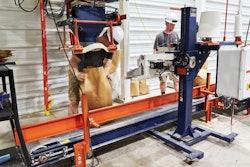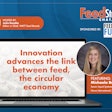
The industry will become more segmented, optimized and fulfill a growing need for protein alternatives
Insects may be the solution to sustainably feeding a projected human population of 10 billion by the year 2050. Insect production uses locally sourced waste to breed a valuable protein source for humans and animals without requiring fertile land or high volumes of water.
Gaining steam due to the environmental and nutritional benefits, the insect industry is projected to grow by 27.8% annually and could be worth nearly US$8 billion by 2030, according to a report from Meticulous Research.
Andreas Baumann, Bühler’s head of market segment insect technology, said the insect industry will be a firm part of the food and feed value chain within two decades.
“The insect approach is not only feasible, but it can be realized on a large scale and in an economical way,” Baumann said. “The technology is available and proven scalable, the legislative framework is provided and interesting application fields for insect-based products have been identified.”
Bühler, based in Uzwil, Switzerland, launched the Insect Technology Initiative in 2012 to develop the market, and by 2019, the company built the world’s largest insect processing plant for Protix.
At the 14,000-square-meter facility located in The Netherlands, black soldier fly larvae are fed organic byproducts from distilleries, food producers, and vegetable collectors to manufacture protein meal and lipids for the animal nutrition sector.
Another industrial-scale insect plant is coming online soon. Agronutris, a French biotechnology company that specializes in rearing and transforming insects into proteins for animal nutrition, contracted Bühler in 2021 to build a new insect plant in France.
Baumann’s involvement in insect production plant development provides him with well-informed insights into this emerging market, and he shared his predictions for the next 20 years.
1. Insect products will win over the consumer base
Though hard to believe by present attitudes on insect consumption, Baumann believes consumers will latch on to insect-based snacks, ingredients and other goods. Like many food labels including organic and non-GMO certified, a sustainability seal or marketing label may someday be applied to insect-derived foods.
“In the supermarket, there will be brands that highlight sustainable products made with the help of insects, but also, applications of insect-based products beyond food, like lubricants, cosmetics, detergents, antimicrobial peptides.”
The main insect species used for food applications at industrial scale are mealworms, crickets and locusts. Food containing insects that are available now and will rise in popularity include:
- Insect flour-based pasta, bread, snacks, cookies or cereal bars
- Culinary products like meat analogues, burger patties or meatballs
- Whole insects with spices as snacks
2. Insect protein as an animal feed ingredient will rise
The poultry, pig, pet and fish sectors will increasingly rely on insect-based protein over the next 15 to 20 years, according to Baumann. Several studies indicate black soldier fly products have beneficial effects on feed conversion rates, gut health, nutrient digestion and meat quality.
“The amino acid profile is very similar to that of fishmeal and is therefore quite attractive,” Baumann said. “In addition to the pure nutritional composition, insect-based ingredients also have functional benefits. The application of insect lipids in piglet diets leads to better weight gain, which helps to optimize growing time.
“This shows that there are already proven benefits allowing for specific applications of the insect-based feed ingredients, however, it is almost certain that there is more to come.”
Agronutris produces a lipidic concentrate rich in lauric acid, a saturated fatty acid, by defatting black fly larvae. Lauric acid has advantages for pet nutrition and health because it is easily digestible and shows natural antimicrobial qualities.
Pet food products containing insects have also been launched for their hypoallergenic and/or anti-inflammatory functionalities.
3. The insect industry will be as segmented as today’s livestock industry
Over time, segmentation will help to make insect production more efficient. There will be companies with specialized breeding programs that deliver high-performing insect strains as well as more insect species used for industrial production.
“There will be feed producers that specifically make feed for insects,” said Baumann. “There will be centralized insect processing hubs to which several farmers deliver their fully grown insects. There will be universities that teach specific insect programs.”
4. Insects will be the preferred technology for organic waste treatment
Roughly a third of the food intended for human consumption is lost or wasted each year, equating to approximately 1.3 billion metric tons that never even reach the table. This is not only a loss of valuable nutrition, but also challenging from a disposal perspective.
Landfills or incineration are the dominant solutions for dealing with food waste, yet they harm the environment.
“There is an ongoing quest for new and efficient technologies to better deal with organic waste,” Baumann said. “Insects are a very good opportunity to deal with waste because they recover nutrients back into the food value chain that are otherwise lost, thereby contributing to a circular economy.”
Large cities especially will increasingly rely on insects to treat their kitchen waste, Baumann predicted.
5. Cost of insect production will decrease
Baumann said solutions and research in four key areas will help lower the overall cost of insect production: product offtake, process optimization, feedstock material and segmentation.
Today, insect ingredients are still a niche market segment with relatively high sales prices. But as more applications for insect protein take off, the increased demand will allow production to benefit from economies of scale.
Process optimization will also play a key role in lowering future production costs.
“The industrial production of insects has just started, so there is still a lot of room for optimization,” Baumann said. “Reduction of water and energy consumption, using higher-performing strains from dedicated breeding programs, and lowering the number of operators required to produce a certain volume of insect meal are just a few examples.”
Feedstock material for larvae makes up a significant cost for insect producers, as most rely on food industry byproducts like potato cut-offs, brewer’s spent grains or wheat bran.
Kitchen waste is a less expensive viable feedstock, however, it is difficult to use due to variations in composition and the risk of mycotoxin contamination.
“By better understanding the metabolism and nutritional requirements of the insects, it will be possible to make feed from lower-grade materials,” Baumann said.
Finally, Baumann predicted insect industry segmentation modeled after the animal protein industry will result in lowered costs.
“Today, nearly all insect companies plan a fully integrated insect plant including insect feed production, a reproduction facility, a grow-out facility and a processing plant for the reared insects. If we look at the traditional livestock industries, these steps are normally managed by different companies,” Baumann said.
Feeding a global population of 10 billion people will require producing an additional 250 million metric tons of protein a year, and insects may play a major role in meeting that target.
As processing technologies are further optimized, insects are poised to become an affordable diet staple for species ranging from poultry to pigs, fish, dogs and even humans.
Announcing the Feed Mill of the Future digital supplement
WATT’s feed brands Feed Strategy and Feed & Grain magazines join forces to launch the monthly Feed Mill of the Future digital supplement. Each edition aims to provide animal feed industry stakeholders with forward-looking content, market insights and a spotlight on the leading-edge technologies shaping the global feed industry of tomorrow.
Subscribe today! https://bit.ly/3dWzow7


















